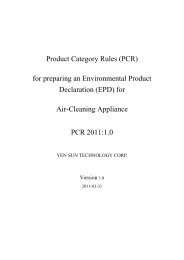Product Category Rules (PCR) - PCR Library
Product Category Rules (PCR) - PCR Library
Product Category Rules (PCR) - PCR Library
Create successful ePaper yourself
Turn your PDF publications into a flip-book with our unique Google optimized e-Paper software.
Annex H (normative): Scenarios for disposal and recycling of containers and packaging<br />
The scenarios for disposal/recycling specified in this <strong>PCR</strong> consist of “H.1 Scenario common to all plastic containers<br />
and packaging,” “H.2 Scenario for designated PET bottles (scenario for individual field),” and “H.3 Scenario for<br />
foamed polystyrene containers (scenario for individual field)”.<br />
Plastic containers and packaging other than those in the individual fields shall be subject to the scenario common to<br />
all plastic containers and packaging.<br />
H.1 Scenario common to all plastic containers and packaging<br />
Used Plastic<br />
Containers and<br />
Packaging<br />
Waste<br />
Collection of resource waste<br />
(recycling)<br />
R1=22%<br />
* When voluntary collection is<br />
implemented:<br />
R1=(1-R4)x22%<br />
Voluntary collection (recycling)<br />
R4=0%<br />
* When voluntary collection is<br />
implemented:<br />
Use primary data for R4.<br />
Trans-<br />
port<br />
A<br />
Incineration<br />
R3=62%<br />
* When voluntary collection is<br />
implemented:<br />
R3=(78%-R4)x80%<br />
H.1.1 Method of calculating ratio between disposal and recycling<br />
Based on the statistic data mentioned below, ratio between disposal and recycling of used plastic containers and<br />
packaging was calculated as follows.<br />
a) Total amount of used plastic containers and packaging: W0<br />
The value obtained by subtracting the amount of designated PET bottles collected, W2 (amount of sorted<br />
collection in municipalities added by amount of collected business-related bottles), in 2008 announced by the<br />
Council for PET Bottle Recycling from the amount of waste containers and packaging, W1 (amount of containers<br />
and packaging in non-industrial waste), in 2008 announced by the Plastic Waste Management Institute:<br />
W1 W2 W0<br />
3.54 million tons - 0.445 million tons = 3.095 million tons<br />
b) Ratio of recycling (collection ratio of resource waste): R1<br />
The value obtained by dividing the amount of sorted collection of containers and packaging, W3 (recycled plastic<br />
containers and packaging), in 2008 by the total amount of used plastic containers and packaging, W0, in the<br />
same year; according to the data announced by the Ministry of Environment:<br />
W3 W0 R1<br />
0.672 million tons / 3.095 million tons = 22%<br />
c) Ratio of landfill: R2<br />
The value obtained by dividing the amount of landfilled non-industrial waste, W4, in 2008 by the total amount of<br />
non-industrial waste, W5, in the same year; according to the data announced by the Plastic Waste Management<br />
Institute:<br />
W4 W5 R2<br />
0.8 million tons / 5.02 million tons = 16%<br />
d) Ratio of incineration: R3<br />
It is assumed that waste is incinerated unless recycled “b) Ratio of recycling” and landfilled “c) Ratio of landfill”.<br />
R1 R2 R3<br />
1 - (22% + 16%) = 62%<br />
e) When voluntary collection is implemented, calculate the annual collection ratio of the containers and packaging,<br />
Landfill<br />
R2=16%<br />
* When voluntary collection is<br />
implemented:<br />
R2=(78%-R4)x20%<br />
Compac-<br />
ting<br />
-26-<br />
* Indirect effect shall not be included in calculation results, but<br />
such information may be included additionally in labeling<br />
in the manner separated from the main information.<br />
Transport<br />
Transport<br />
Material recycling<br />
Chemical recycling<br />
Material recycling<br />
Chemical recycling















